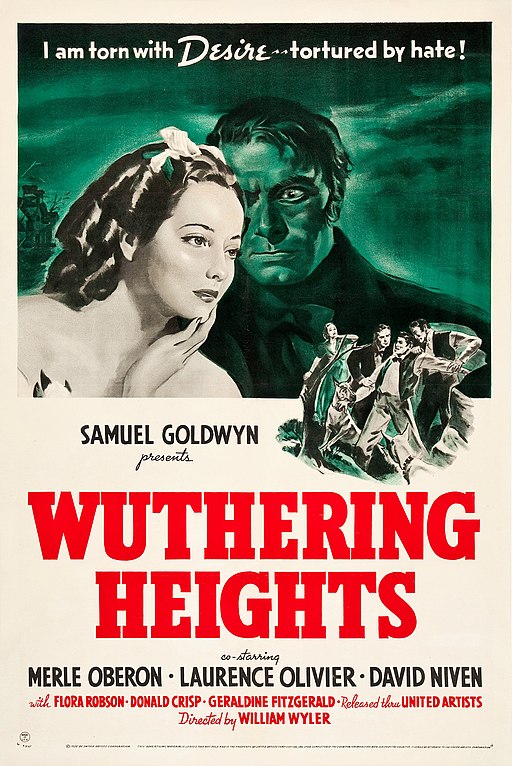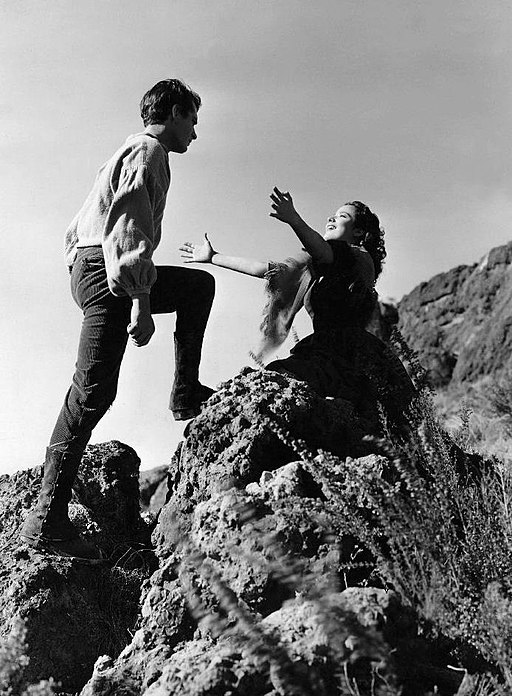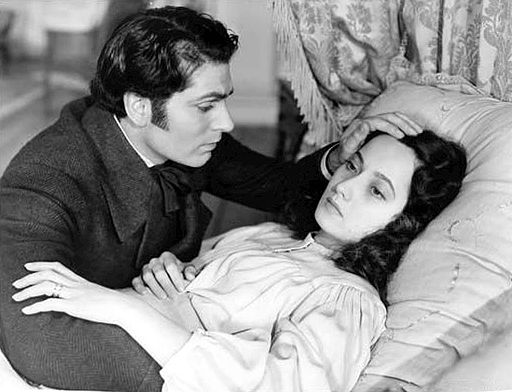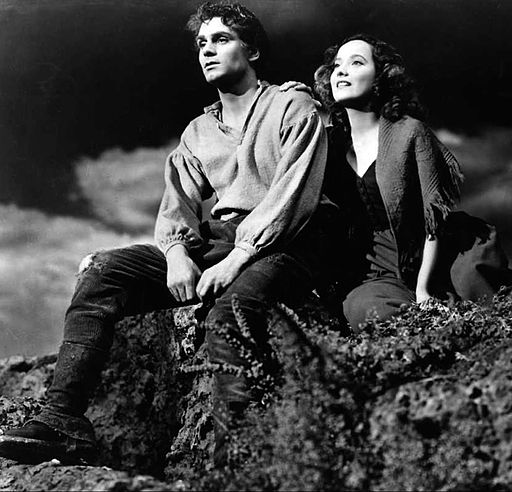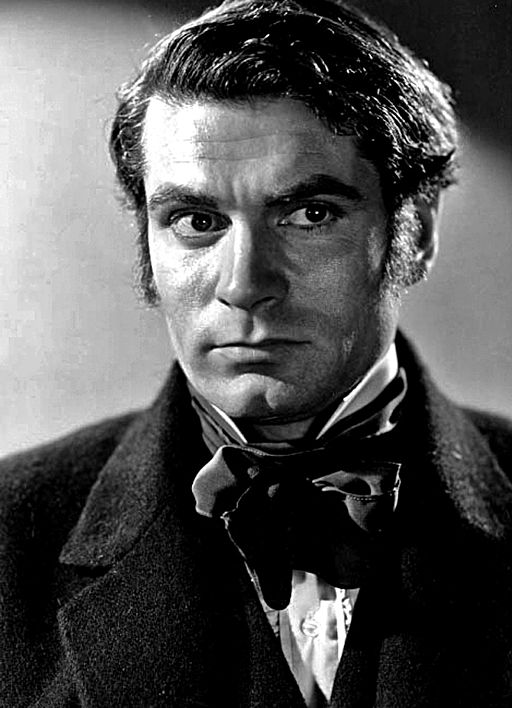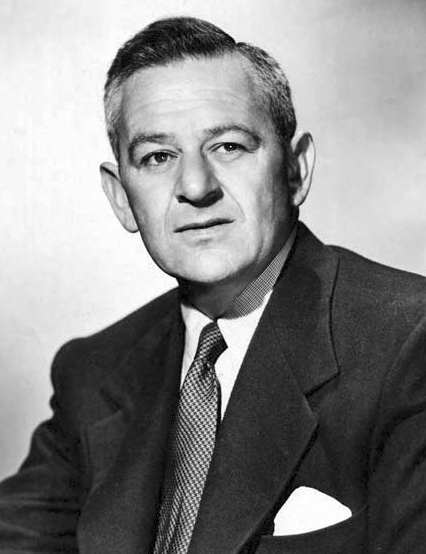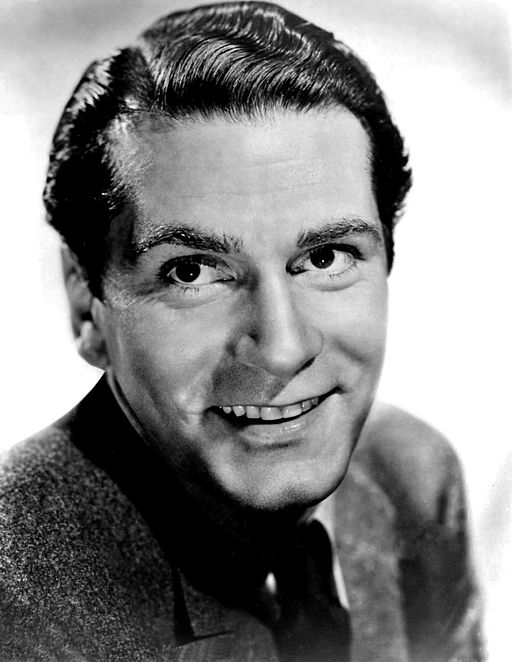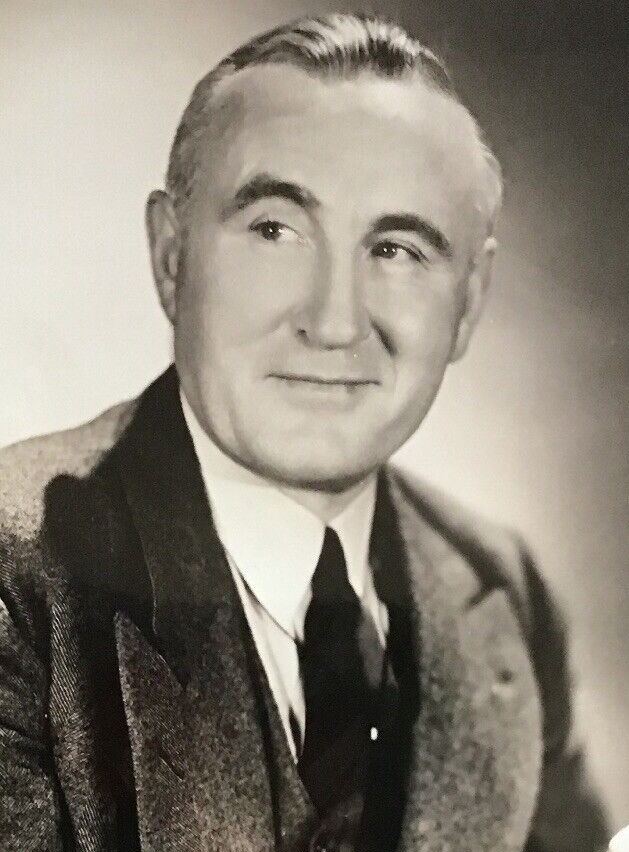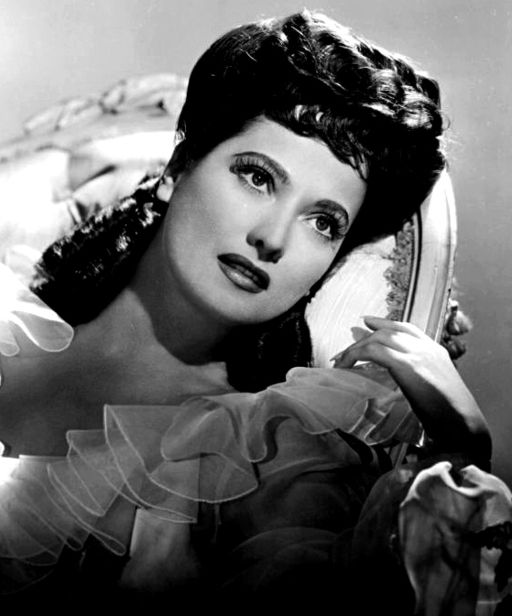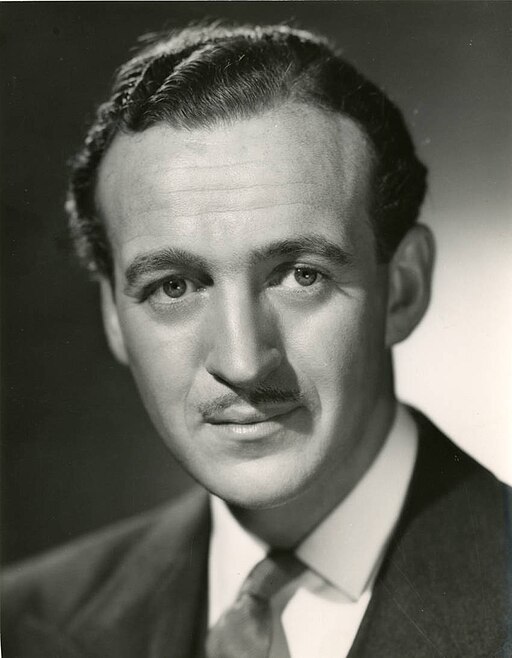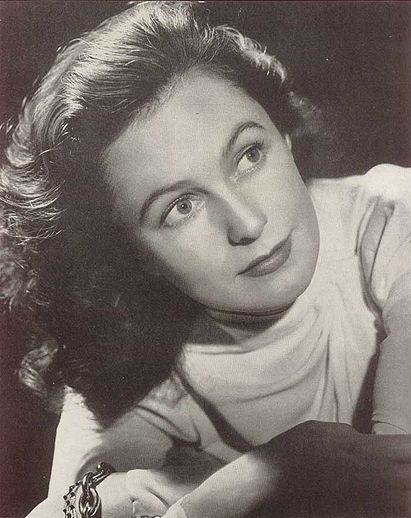Wuthering Heights - 1939
back| Released by | United Artists |
| Director | William Wyler |
| Producer | Samuel Goldwyn |
| Script | Charles MacArthur and Ben Hecht, based on the novel by Emily Brontë |
| Cinematography | Gregg Toland |
| Music by | Alfred Newman |
| Running time | 104 minutes |
| Film budget | Unknown |
| Box office sales | $ 625.000,- |
| Main cast | Merle Oberon - Laurence Olivier - David Niven - Flora Robson - Donald Crisp |
Wuthering Heights
A haunting tale of doomed love set against the brooding Yorkshire moors
"Wuthering Heights" (1939) is celebrated for its atmospheric cinematography by Gregg Toland, who later worked on "Citizen Kane," and its score by Alfred Newman. The film diverges from Emily Brontë's novel in some respects, focusing mainly on the tragic romance between Heathcliff and Cathy.
It is remembered as one of the classic adaptations of literature to cinema, showcasing Wyler's direction and the compelling performances of its lead actors. This adaptation remains a staple in discussions of classic Hollywood cinema and has been praised for its emotional depth and visual style.
Related
Wuthering Heights – 1939
"Wuthering Heights" (1939), directed by William Wyler, is an evocative adaptation of Emily Brontë's 1847 novel of the same name. It stands as a quintessential example of Hollywood's golden era of filmmaking, distinguished by its stirring performances, atmospheric cinematography, and haunting musical score. The film captures the tragic romance between Heathcliff and Cathy, set against the bleak and stormy Yorkshire moors, which serve as a poignant backdrop to their tumultuous relationship.
Summary
The story begins with Mr. Earnshaw bringing home an orphan, Heathcliff, to live with his family at Wuthering Heights. Heathcliff forms a deep and passionate bond with Earnshaw's daughter, Cathy. Despite their intense connection, societal expectations and class differences create insurmountable obstacles to their union. Cathy eventually marries Edgar Linton, a wealthy neighbor, causing Heathcliff to leave Wuthering Heights, heartbroken.
Years later, Heathcliff returns as a wealthy man, seeking revenge on those he believes wronged him, including Cathy and the Linton family. The film focuses on Heathcliff's destructive path and his undying love for Cathy, which ultimately leads to tragedy. Unlike the novel, which spans two generations, the film concentrates on the first generation's story, ending with Cathy's death and Heathcliff's despair, simplifying Brontë's complex narrative for cinematic purposes.
Analysis
Wyler's "Wuthering Heights" is celebrated for its gothic romanticism, beautifully captured through Gregg Toland's pioneering deep-focus cinematography. The moors are depicted as a character in their own right, their desolation mirroring the internal turmoil of the protagonists. This visual style, combined with Alfred Newman's emotive score, enhances the film's melancholic atmosphere, making the landscape and setting integral to the narrative's emotional impact.
The casting of Laurence Olivier as Heathcliff and Merle Oberon as Cathy was pivotal, with Olivier's brooding intensity and Oberon's ethereal beauty encapsulating the doomed lovers' essence. Their performances convey the depth of Heathcliff and Cathy's passion, their societal constraints, and ultimate despair with profound sensitivity.
The screenplay adaptation by Charles MacArthur and Ben Hecht, while diverging from Brontë's original work, skillfully distills the novel's essence into a more concise narrative. This adaptation emphasizes the romantic elements over the novel's broader themes, including social commentary and moral reflection, focusing on the love story's emotional core.
Conclusion
William Wyler's "Wuthering Heights" remains a landmark in film history, notable for its artistic achievements and faithful representation of the novel's spirit, if not its entire plot. The film explores themes of love, revenge, and the destructive power of obsession, set against a backdrop that is as beautiful as it is bleak. It's a testament to the enduring power of Brontë's story and a masterpiece of cinematic adaptation that continues to captivate audiences with its timeless romance and tragedy.
Classic Trailer Wuthering Heights 1939:
Full Cast of the Movie:
- Merle Oberon as Catherine Earnshaw Linton (Cathy)
- Laurence Olivier as Heathcliff
- David Niven as Edgar Linton
- Flora Robson as Ellen Dean (Nelly)
- Donald Crisp as Dr. Kenneth
- Geraldine Fitzgerald as Isabella Linton
- Hugh Williams as Hindley Earnshaw
- Leo G. Carroll as Joseph
- Miles Mander as Mr. Lockwood
- Cecil Kellaway as Earnshaw
- Sarita Wooton as Young Cathy
- Rex Downing as Young Heathcliff
- Douglas Scott as Young Hindley
- Alice Brandt as Frances
- Harold Entwistle as Dr. Kenneth's Servant
- Peter Shaw as Hareton (uncredited)
Analysis of William Wyler’s Direction:
William Wyler's direction of "Wuthering Heights" (1939) is a testament to his mastery of cinematic storytelling and his ability to evoke deep emotional responses from his audience. Wyler, known for his meticulous attention to detail and insistence on perfect performances, brings Emily Brontë's classic novel to the screen with a keen sense of atmosphere, character depth, and dramatic tension. His direction in this film is characterized by several distinctive features:
Visual Storytelling
Wyler, collaborating with cinematographer Gregg Toland, employs a visual style that significantly contributes to the film's gothic romanticism. The use of deep focus cinematography allows for intricate compositions where the foreground, middle ground, and background are all in sharp focus simultaneously. This technique is used to enhance the emotional depth and thematic complexity of scenes, allowing the bleak and stormy moors to become a constant, oppressive presence that mirrors the turbulent emotions of the characters. Wyler's framing often isolates characters against the vast landscapes or confines them in tight interiors, visually representing their emotional isolation or entrapment.
Performance Direction
Wyler is renowned for his ability to extract profound and nuanced performances from his actors, and "Wuthering Heights" is no exception. He guided Laurence Olivier (Heathcliff) and Merle Oberon (Cathy) through performances that are both intense and nuanced, capturing the passionate yet destructive nature of their characters' relationship. Wyler's insistence on authenticity and emotional truth in performances helped Olivier and Oberon convey a palpable sense of longing and despair that resonates with the audience. Under his direction, even the supporting cast delivers memorable performances that add depth to the story's world.
Pacing and Narrative Structure
Wyler's pacing of "Wuthering Heights" adeptly balances the dramatic momentum with moments of quiet introspection, allowing the audience to fully immerse themselves in the emotional landscape of the story. He skillfully condenses Emily Brontë's sprawling novel into a coherent narrative that remains focused on the central romance while still hinting at the broader themes of social class, revenge, and the cyclical nature of suffering. Wyler's ability to maintain narrative tension while exploring the complex internal lives of his characters is a hallmark of his directorial approach.
Emotional Depth
Perhaps one of Wyler's greatest achievements in "Wuthering Heights" is the film's profound emotional depth. He crafts a world that feels intensely real and raw, drawing the audience into the heartache, passion, and tragedy experienced by Heathcliff and Cathy. Wyler's direction ensures that the emotional stakes are always clear and that the characters' motivations and feelings are deeply felt by the audience. This emotional engagement is achieved through a combination of performance direction, visual storytelling, and the evocative use of music and sound.
Great Performance of Merle Oberon:
Merle Oberon's performance as Catherine Earnshaw Linton in William Wyler's "Wuthering Heights" (1939) stands as a pivotal element of the film's emotional depth and enduring appeal. Oberon, with her ethereal beauty and nuanced acting, brings to life the complex character of Cathy, embodying the contradictions and passions of Emily Brontë's heroine. Her portrayal is marked by several key attributes that contribute to the film's success and the character's legacy in cinematic history.
Ethereal Presence
Oberon's screen presence has an almost ethereal quality that perfectly suits the character of Cathy. Her striking looks and graceful demeanor capture the otherworldly aspect of Cathy, who seems torn between the earthly and spiritual realms. This quality is essential for a character who is deeply rooted in the rugged landscapes of the Yorkshire moors, yet dreams of a life beyond her circumstances. Oberon's ability to project both vulnerability and a certain untouchable quality adds a layer of complexity to Cathy, making her both sympathetic and enigmatic.
Emotional Range
One of the most notable aspects of Oberon's performance is her emotional range. Cathy is a character of intense passions, torn between her love for Heathcliff and the societal expectations represented by her marriage to Edgar Linton. Oberon navigates these emotional extremes with finesse, shifting seamlessly from moments of tender affection with Heathcliff to scenes of distress and conflict. Her portrayal of Cathy's inner turmoil—her longing, guilt, and eventual despair—is compelling and authentic, anchoring the film's dramatic tension.
Chemistry with Co-Stars
The chemistry between Oberon and Laurence Olivier (Heathcliff) is central to the film's portrayal of the doomed love affair. Oberon's interactions with Olivier convey a profound connection, filled with intensity and unspoken understanding. This chemistry is not just a testament to their individual talents but also to Oberon's ability to convey deep emotional truths through her performance. Additionally, her dynamics with David Niven (Edgar Linton) effectively illustrate Cathy's divided loyalties and the societal pressures she faces.
Subtlety and Complexity
Oberon's portrayal is notable for its subtlety and the complexity she brings to the role. Cathy is a character who could easily be misunderstood or oversimplified, but Oberon navigates the nuances of her personality with skill. She portrays Cathy's strength and willfulness, as well as her sensitivity and capacity for great love. Oberon's performance captures the essence of Cathy's struggle, making her a relatable and tragic figure.
Impact on the Film's Legacy
Merle Oberon's performance in "Wuthering Heights" has been widely recognized as one of her career's highlights. She brings a depth and luminosity to the role that has contributed significantly to the film's status as a classic of American cinema. Her Cathy is both of her time and timeless, a testament to Oberon's talent and understanding of the character.
In conclusion, Merle Oberon's portrayal of Cathy in "Wuthering Heights" is a masterclass in film acting, marked by its emotional depth, complexity, and the ethereal quality she brings to the screen. Her performance not only captures the spirit of Emily Brontë's heroine but also elevates the film to a work of profound emotional resonance.
Notable Quotes from “Wuthering Heights”:
Heathcliff: "Cathy, you're a part of me. You're my heart and my soul."
This line underscores the deep, almost transcendental connection between Heathcliff and Cathy, highlighting the intensity of their love and the way they perceive each other as integral to their very being.
Cathy: "Whatever our souls are made of, his and mine are the same."
A direct echo from Emily Brontë's novel, this quote is perhaps one of the most famous and speaks to the profound bond between Heathcliff and Cathy, suggesting a predestined, soul-deep connection that transcends social boundaries and personal turmoil.
Heathcliff: "I pray one prayer—I repeat it till my tongue stiffens—Catherine Earnshaw, may you not rest as long as I am living! You said I killed you—haunt me, then! The murdered do haunt their murderers. I believe—I know that ghosts have wandered on earth. Be with me always—take any form—drive me mad! Only do not leave me in this abyss, where I cannot find you!"
This passionate plea by Heathcliff captures his torment and obsession with Cathy even beyond death, illustrating the Gothic elements of the story and the depth of his love and desperation.
Cathy: "Heathcliff, make the world stop right here. Make everything stop and stand still and never move again. Make the moors never change and you and I never change."
Cathy's longing for a timeless, unchanging world reflects her desire to escape the constraints of societal expectations and her conflicting emotions, yearning for a space where her love for Heathcliff could exist unchallenged.
Ellen Dean: "Time will change him, you'll see. He'll marry some young lady, and love will make him a new man." Cathy: "Time will change him, but it can't change me, not in the way you mean. I could never marry Heathcliff now; but my love for him remains what it was. My great miseries in this world have been Heathcliff's miseries, and I watched and felt each from the beginning. My great thought in living is himself. If all else perished, and he remained, I should still continue to be; and if all else remained, and he were annihilated, the universe would turn to a mighty stranger."
This exchange highlights the complexity of Cathy's feelings, torn between societal expectations and her immutable love for Heathcliff, which she views as the essence of her existence.
Heathcliff: "I never want to see your face again." Cathy: "Nor I yours."
A moment of anger and hurt, this exchange belies the deep love and connection they share, encapsulating the tragic nature of their relationship, where pride and circumstance often come between them.
Awards and Recognition:
Academy Awards (Oscars)
- Nominated for Best Picture
- Nominated for Best Director (William Wyler)
- Nominated for Best Actor (Laurence Olivier)
- Nominated for Best Supporting Actress (Geraldine Fitzgerald)
- Nominated for Best Writing, Screenplay (Charles MacArthur and Ben Hecht)
- Nominated for Best Art Direction (James Basevi)
- Nominated for Best Cinematography, Black-and-White (Gregg Toland)
- Nominated for Best Music, Original Score (Alfred Newman)
- Won for Best Cinematography, Black-and-White (Gregg Toland)
New York Film Critics Circle Awards
- Won Best Director (William Wyler)
Other Honors and Recognitions
Beyond these specific awards, "Wuthering Heights" has been acknowledged by various film institutions and preserved for its cultural, historical, and aesthetic significance:
- The film has been selected for preservation in the United States National Film Registry by the Library of Congress as being "culturally, historically, or aesthetically significant."
- It is often cited in various critical and public polls for its performances, direction, cinematography, and as an adaptation of Emily Brontë's novel.

